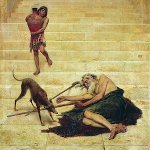Saint Lazarus Day in Cuba Date in the current year: December 17, 2026
 On December 17, Western Churches celebrate the feast day of Saint Lazarus of Bethany. In Cuba, Saint Lazarus Day (San Lázaro) is a major festival that combines the elements of Roman Catholicism and Santería, a syncretic polytheistic religion that developed in Cuba during the colonial period.
On December 17, Western Churches celebrate the feast day of Saint Lazarus of Bethany. In Cuba, Saint Lazarus Day (San Lázaro) is a major festival that combines the elements of Roman Catholicism and Santería, a syncretic polytheistic religion that developed in Cuba during the colonial period.Lazarus of Bethany, also known of Lazarus of the Four Days, was a follower of Jesus from Bethany who was resurrected by Jesus four days after his death. The biblical narrative of his raising can be found in the Gospel of John. When Lazarus fell ill, his sisters Mary and Martha sent word to Jesus. When Jesus arrived in Bethany, Lazarus had already been dead for four days. Jesus came to his tomb, said a prayer and called Lazarus to come out, which he did.
Lazarus of Bethany is often conflated with the beggar Lazarus from the parable of the rich man and Lazarus that is told in the Gospel of Luke. The parable tells of the relationship between a beggar named Lazarus and an unnamed rich man. Lazarus was laid at the rich man’s gate, covered with sores and longing to eat scraps from his table. When Lazarus died, he was sent to heaven, and the rich man went to hell after his death. The beggar Lazarus is the patron saint of the poor and lepers.
Although Lazarus of Bethany and the beggar Lazarus are two separate characters from different Gospels, they have often been conflated. The feast day of the beggar Lazarus is observed on June 28, but some churches perform rites associated with him on December 17, the feast day of Saint Lazarus of Bethany.
The conflation of the characters has become an important figure in Santería, a religion that developed through syncretism between the Yoruba religion brought to Cuba by West African slaves who worked on plantations and Roman Catholicism, which was the religion of the Spanish colonizers. The name “Santería” was given to the religion by the Spanish; some practitioners prefer to call it Lucumí, considering the term “Santería” offensive.
In Santería, Saint Lazarus is associated with Babalú-Ayé, the orisha (spirit) of healing in all its aspects, but especially the healing of skin diseases, inflammation, seizures, and airborne diseases responsible for epidemics. Babalú-Ayé is most likely associated with Lazarus because the beggar Lazarus is depicted covered with sores and so is Babalú-Ayé.
Babalú-Ayé is one of the most venerated orishas in Santería. Conflated with both Lazaruses, he is honored with an annual pilgrimage to the Church and Leprosorium of Saint Lazarus in El Rincón that occurs on December 17. Tens of thousands of devotees from all over the country come to the church to pray to Saint Lazarus/Babalú-Ayé and ask him for health or protection for themselves and their families.
Some of the pilgrims walk barefoot or on their knees, crawl, or carry a cross or a stone on their backs to show their devotion; some wear symbolic garments made of sackcloth and purple fabrics associated with the beggar Lazarus. They often leave the offerings of candles, flowers and coins to appease the saint.
- Category
- Religious Holidays, Folk Festivals
- Country
- Cuba
- Tags
- Saint Lazarus Day in Cuba, holidays in Cuba, religious holidays, folk festivals, Santería, Babalú-Ayé